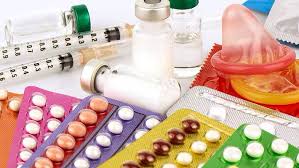Symptoms
Accuracy of symptoms
Two case studies are applicable here. The first found that women with ovarian cancer had symptoms of increased abdominal size, bloating, urge to pass urine and pelvic pain. The smaller, second study found that women with ovarian cancer had pelvic/abdominal pain, increased abdominal size/bloating, and difficulty eating or feeling full.
Consensus statement
In 2007, the Gynecologic Cancer Foundation, Society of Gynecologic Oncologists and American Cancer Society originated the following consensus statement regarding the symptoms of ovarian cancer.
Ovarian cancer is called a “silent killer” because symptoms were not thought to develop until the disease had advanced and the chance of cure or remission poor. However, the following symptoms are much more likely to occur in women with ovarian cancer than women in the general population. These symptoms include:
• Bloating
• Pelvic or abdominal pain
• Pain in the back or legs
• Diarrhea, gas, nausea, constipation, indigestion
• Difficulty eating or feeling full quickly
• Urinary symptoms (urgency or frequency)
• Pain during sex
• Abnormal vaginal bleeding
• Trouble breathing
Women with ovarian cancer report that symptoms are persistent and represent a change from normal for their bodies. The frequency and/or number of such symptoms are key factors in the diagnosis of ovarian cancer. Several studies show that even early stage ovarian cancer can produce these symptoms. Women who have these symptoms almost daily for more than a few weeks should see their doctor, preferably a gynecologist. Prompt medical evaluation may lead to detection at the earliest possible stage of the disease. Early stage diagnosis is associated with an improved prognosis.
Other symptoms:
Several other symptoms have been commonly reported by women with ovarian cancer.
These symptoms include fatigue, indigestion, back pain, pain with intercourse, constipation and menstrual irregularities. However, these other symptoms are not as useful in identifying ovarian cancer because they are also found in equal frequency in women in the general population who do not have ovarian cancer
Epidemiology
The exact cause is usually unknown. The disease is more common in industrialized nations, with the exception of Japan. In the United States, females have a 1.4% to 2.5% (1 out of 40-60 women) lifetime chance of developing ovarian cancer. Older women are at highest risk.[citation needed] More than half of the deaths from ovarian cancer occur in women between 55 and 74 years of age and approximately one quarter of ovarian cancer deaths occur in women between 35 and 54 years of age.
Cause
The exact cause is usually unknown. The risk of developing ovarian cancer appears to be affected by several factors. The more children a woman has, the lower her risk of ovarian cancer. Early age at first pregnancy, older age of final pregnancy and the use of low dose hormonal contraception have also been shown to have a protective effect. Ovarian cancer is reduced in women after tubal ligation.
Hormones
The relationship between use of oral contraceptives and ovarian cancer was shown in a summary of results of 45 case-control and prospective studies. Cumulatively these studies show a protective effect for ovarian cancers. Women who used oral contraceptives for 10 years had about a 60% reduction in risk of ovarian cancer. (risk ratio .42 with statistical significant confidence intervals given the large study size, not unexpected). This means that if 250 women took oral contraceptives for 10 years, 1 ovarian cancer would be prevented. This is by far the largest epidemiological study to date on this subject (45 studies, over 20,000 women with ovarian cancer and about 80,000 controls)
The link to the use of fertility medication, such as Clomiphene citrate, has been controversial. An analysis in 1991 raised the possibility that use of drugs may increase the risk of ovarian cancer. Several cohort studies and case-control studies have been conducted since then without demonstrating conclusive evidence for such a link. [17] It will remain a complex topic to study as the infertile population differs in parity from the "normal" population.
Genetics
There is good evidence that in some women genetic factors are important. Carriers of certain mutations of the BRCA1 or the BRCA2 gene are notably at risk. The BRCA1 and BRCA2 genes account for 5%-13% of ovarian cancers[18] and certain populations (e.g. Ashkenazi Jewish women) are at a higher risk of both breast cancer and ovarian cancer, often at an earlier age than the general population.[citation needed] Patients with a personal history of breast cancer or a family history of breast and/or ovarian cancer, especially if diagnosed at a young age, may have an elevated risk.
A strong family history of uterine cancer, colon cancer, or other gastrointestinal cancers may indicate the presence of a syndrome known as hereditary nonpolyposis colorectal cancer (HNPCC, also known as Lynch II syndrome), which confers a higher risk for developing ovarian cancer. Patients with strong genetic risk for ovarian cancer may consider the use of prophylactic, i.e. preventative, oophorectomy after completion of childbearing.[citation needed] Australia being member of International Cancer Genome Consortium is leading efforts to map ovarian cancer’s complete genome.
Alcohol
A pooled analysis of ten prospective cohort studies conducted in a number of countries and including 529,638 women found that neither total alcohol consumption nor alcohol from drinking beer, wine or spirits was associated with ovarian cancer risk."The results of a case-control study in the region of Milan, Italy, "suggests that relatively elevated alcohol intake (of the order of 40 g per day or more) may cause a modest increase of epithelial ovarian cancer risk"[
"Associations were also found between alcohol consumption and cancers of the ovary and prostate, but only for 50 g and 100 g a day."[]"Statistically significant increases in risk also existed for cancers of the stomach, colon, rectum, liver, female breast, and ovaries."
A Swedish study, which followed more than 61,000 women for 13 years, has found a significant link between milk consumption and ovarian cancer. According to the BBC, "[Researchers] found that milk had the strongest link with ovarian cancer—those women who drank two or more glasses a day were at double the risk of those who did not consume it at all, or only in small amounts."
Recent studies have shown that women in sunnier countries have a lower rate of ovarian cancer, which may have some kind of connection with exposure to Vitamin D.
Other factors that have been investigated, such as talc use, asbestos exposure, high dietary fat content, and childhood mumps infection, are controversial and have not been definitively proven.
Diagnosis
Ovarian cancer at its early stages is difficult to diagnose until it spreads and advances to later stages. This is because most of the common symptoms are non-specific.
When an ovarian malignancy is included in the list of diagnostic possibilities, a limited number of laboratory tests are indicated. A complete blood count (CBC) and serum electrolyte test should be obtained in all patients.
Prevention
There are a number of ways to reduce or eliminate the risk of ovarian cancer. Pregnancy before the age of 25 as well as breastfeeding provides some reduction in risk. Tubal ligation and hysterectomy reduce the risk and removal of both ovaries (bilateral oophorectomy) nearly eliminates the risk. The use of oral contraceptives (birth control pills) for five years or more decreases the risk of ovarian cancer in later life by 50%.
















Discussion about this post